Agile Organisation - Week 1
- initiating, changing and solidifying a change
- Lewings 3 stages model
- McKinsey 7s model
Lewings 3 stages model
- Unfreeze - Change - Freeze
- Why the change is needed
- Why now?
- What are the benefits?
- What are consequences of not changing?
- Find new ways of doing things and adopt the changes
- How does that connect with companies Values?
- Look at value of dispair curve
- Bring orga back to stability
- Celebrate the success and mark an end of that change
- One can compare that to bringing an ice cube into a new form
Kurt Lewin’s Change Management Model: The Planned Approach to Organizational Change
MCKinsey 7s
- 📖 In Search of Excellence - Thomas J. Peters
- brings a cross functional team together to use 7s for analysis and then implementing a change
- Note: 7s can nicely be combined with Lean Change to fill the Lean change canvas
- McKinsey 7S Framework case study
- Enduring Ideas: The 7S Framework
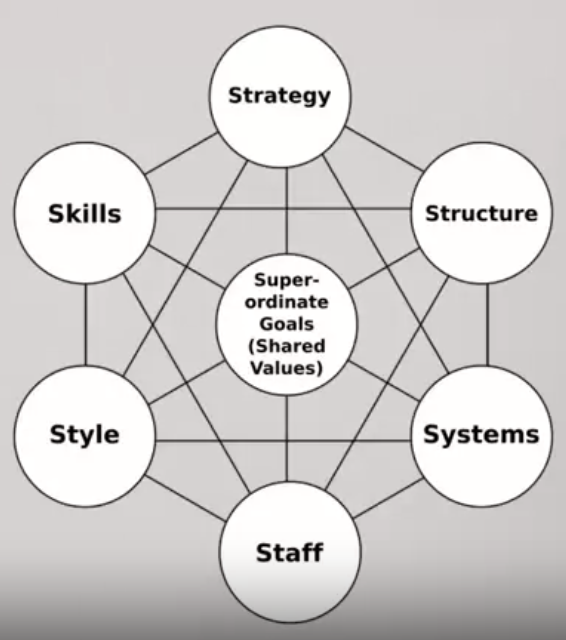
Hard Components - Strategy - Structure - Systems
- clearly defined, can be analyses and more easily be influenced
Soft Components - skills - styles - staff - shared values
intangible and difficult to define
Strategy
plan of how to gain and keep market share, it’s how to gain and maintain the competitive advantage.
Structure
Structure, explains how your business is organized in terms of hierarchy, how decisions are made, and who reports to who
Systems
Systems are processes that your organization relies upon to keep business going, software, hardware, and standard operating procedures
Style
Style, represents a leadership style adopted throughout the organization.
Steps for using 7s
- identify where your particular change belongs within the 7S elements
- analyze the alignment between this change in your organization’s foundation, which has expressed their shared values.
- How will this new change influence shared values?
- What needs to change to support the alignment between the impact of change and shared values?
- Are shared values align with the other hard elements of systems and structure?
- If not, what needs to be done to align them?
- analyze soft elements. Do they support the hard elements after we consider the impact of the change?
Week 2 - further change models
Nudge Theory
Nudge uses the power of suggestion and positive reinforcement to influence the environment in such a way that it supports the best decision making.
- For people side of change
- 📖 Nudge - Improving decisions about Health, Wealth and Happiness
- build a people centric culture
- present options and
- address resistance to change
- Checklist for applying the Nudge Theory
- What Can Nudge Theory Teach Us About Organizational Change? Using subtlety to create incremental, sustainable change
Perception Nudge
- focus on changing current perception
Motivation Nudge
- focus on current motivations
Ability Nudge
- focus on needed abilities
7 Steps
- clearly define the change you’re planning to implement.
- think of how this planned change would impact employees from their point of view.
- analyze available options based on data and facts.
- present options for change.
- gather and incorporate feedback.
- remove as many obstacles as possible.
- celebrate and keep the momentum up with low-hanging fruit wins and rewards
Underlying theories
- Not wanting to be left out
- FOMO
- Employees want to be treated as individuals
- Remove as many obstacles as possible
ADKAR Model
- Must address people and organization dimension simultanuously
- identify a business problem or a need for change.
- determine project scope, objectives and timelines.
- develop a solution.
-
implement a new solution.
- Awareness of the need to change, which is achieved through communication.
- Desire represents a level of enthusiasm and willingness to engage with and support change.
- Knowledge answers a question of how to change, knowledge is developed through proper training or coaching.
- Ability is about implementing change, is the required performance level. Ability is typically achieved through training and practice over time.
-
Reinforcement of new behaviors is achieved through adoption rate evaluations, correction and celebration of successful change.
- Combine with GROW
- Good for communicating change
ADKAR checklist How to take ADKAR from theory to practice ADKAR personal transformation form
Kotters 8 Steps Model
📖 XLR8 Accelerate Transition case studies Kotter’s 8 Step Model case study
Define the opportunity
- create a sense of urgency.
- communicate benefit, why now
- to employees and leadership (gain at least 75% support)
- explain missed opportunities
- build a powerful coalition.
- Power Interest/Influence grid
- develop a strategic vision.
- clear roadmap
- begin with end in mind
- this becomes your elevator pitch
- align with culture of the organisation (so combine with 7s)
- enlists change advocates.
- who will support
- town halls, ADKAR focus groups (5-8 employees)
- enable action by removing obstacles.
- address risks quickly
- have regular sessions
- use 7s
- generate short-term wins.
- keep high momentum and motivation
- celebrate
- demonstrate to leadership and tell story of success
- sustain change acceleration.
- double down on change
- be clear about what to do next
- institute change.
- embed in culture
- monitor for 90 days
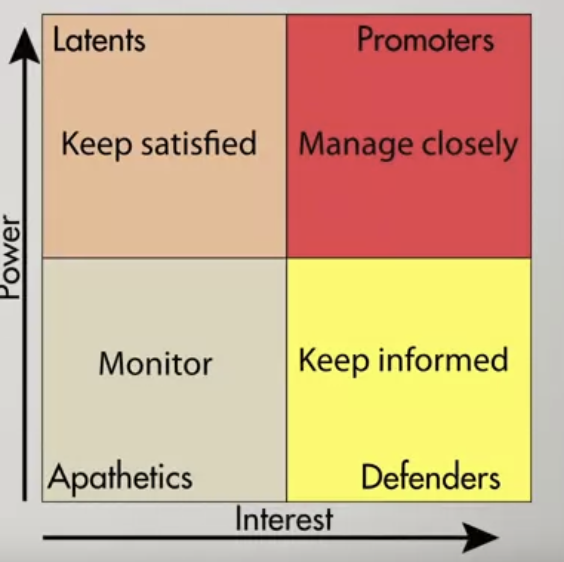
Kubler-Ross Five Stages of Grief
- What happens to human during a change.
- In complex and fast paced changes.
- supports Sense of belonging
5 Stages:
- Denial
- Schock, avoidance tactics
- Anger
- sense of helplessness
- Bargaining
- try to postpone the change
- feeling of guilt
- WHAT IF
- Depression
- feeling, sick more often
- Why should I give my best or event contribute
- Acceptance
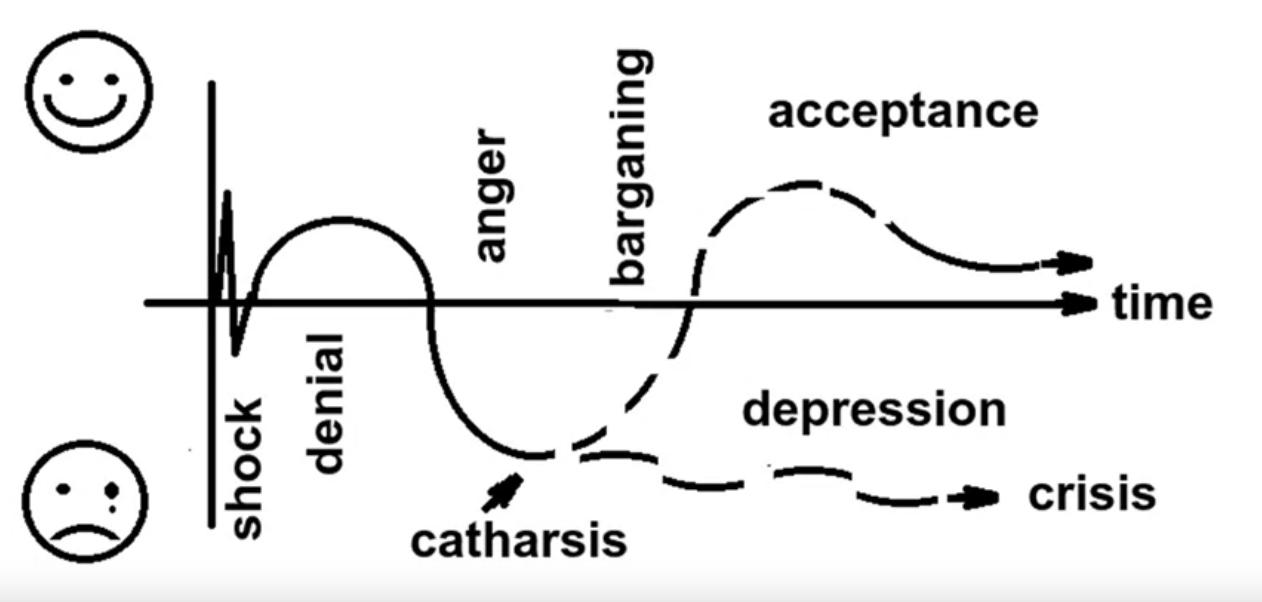
- different pace for everyone
Bridges Transition Models
📖 Transitions by William Bridges - making sense of life’s changes Combine with ADKAR or 7s
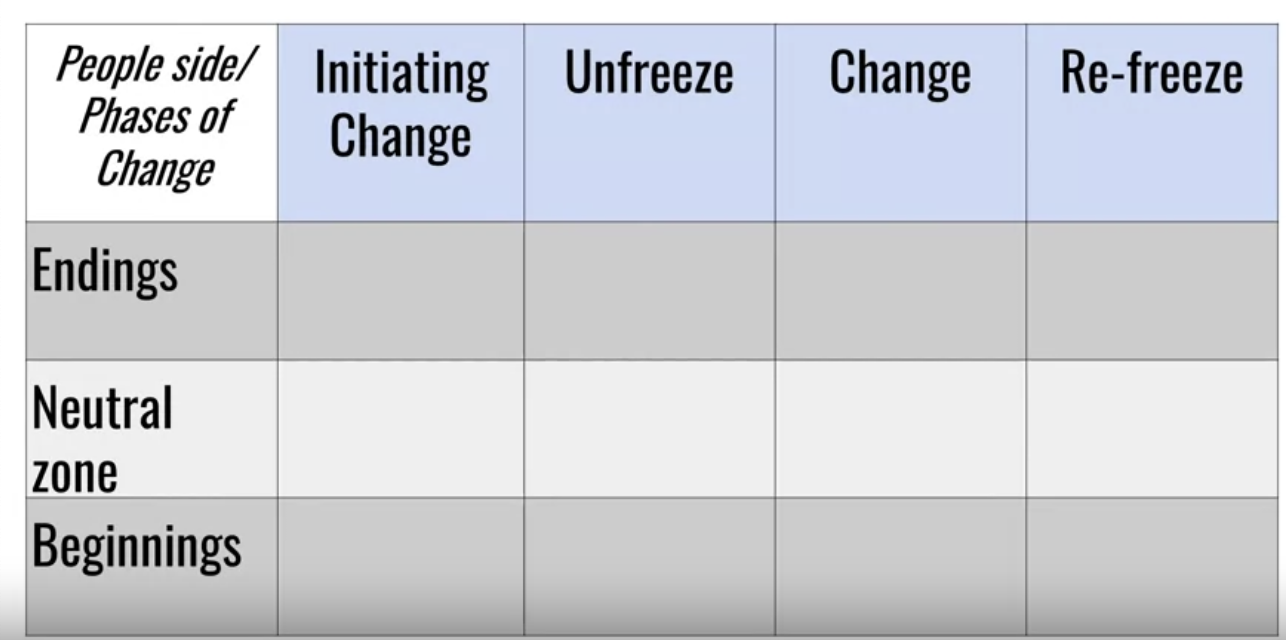
3 stages:
- ending of current state
- what they are losing
- openly talk about emotions and feelings
- neutral zone
- between old and new … the heart of the transition
- skeptical and frustration, maybe even sabotages
- continue to care, offer training and encouragement
- new beginning
- see how they contribute
- see benefits of the change
Change is external Transition is internal to people facing change. Takes time as psychological process are involved. Allow time to transitions.
Week 3 - Stages of Agile Adoption
three most common definitions of an agile enterprise:
- follows the philosophy and principles of agile and is quick in its response to changes
- agile enterprise means having dozens of agile teams working on projects across the organization. What this definition describes is agile at scale
- agile enterprise is one that has fully adopted agile philosophy and values throughout the organization. It’s prepared to capitalize on last minute opportunities and has a unique balance of bureaucracy, an flexibility that supports the delivery of higher customer value
Scaling Agile
- stages: no agile - agile at scale - agile enterprise
- ensure that your organization has a vision and that it prioritizes customer value.
- BAHG - Big Audacious Hairy Goal - to inspire and energize employees, and reinvigorate a stale mission
- refresh on vision and values
- prove that the Agile has merit, pilot it.
- prove the value with smaller units and wins
- remove points of friction and transform business processes to support Agile teams
Some of the examples of where to deploy agile teams are developing a new product, creating an innovative experience for the customer, improving business processes or developing new technology.
Case studies
Amazon
They include a constant obsession with customers, a culture of innovation, the implementation and use of Agile teams, modulus structure, and fast incremental delivery cycles.
Amazon company values:
- Amazon leadership and employees have a sense of ownership.
- leading by setting a standard of innovative thinking on behalf of customer needs.
- staying curious to learn more about the customers.
- delivering your results.
- respectfully challenging compromises,
- thinking big and taking care of details.
Template for proposing a new idea:
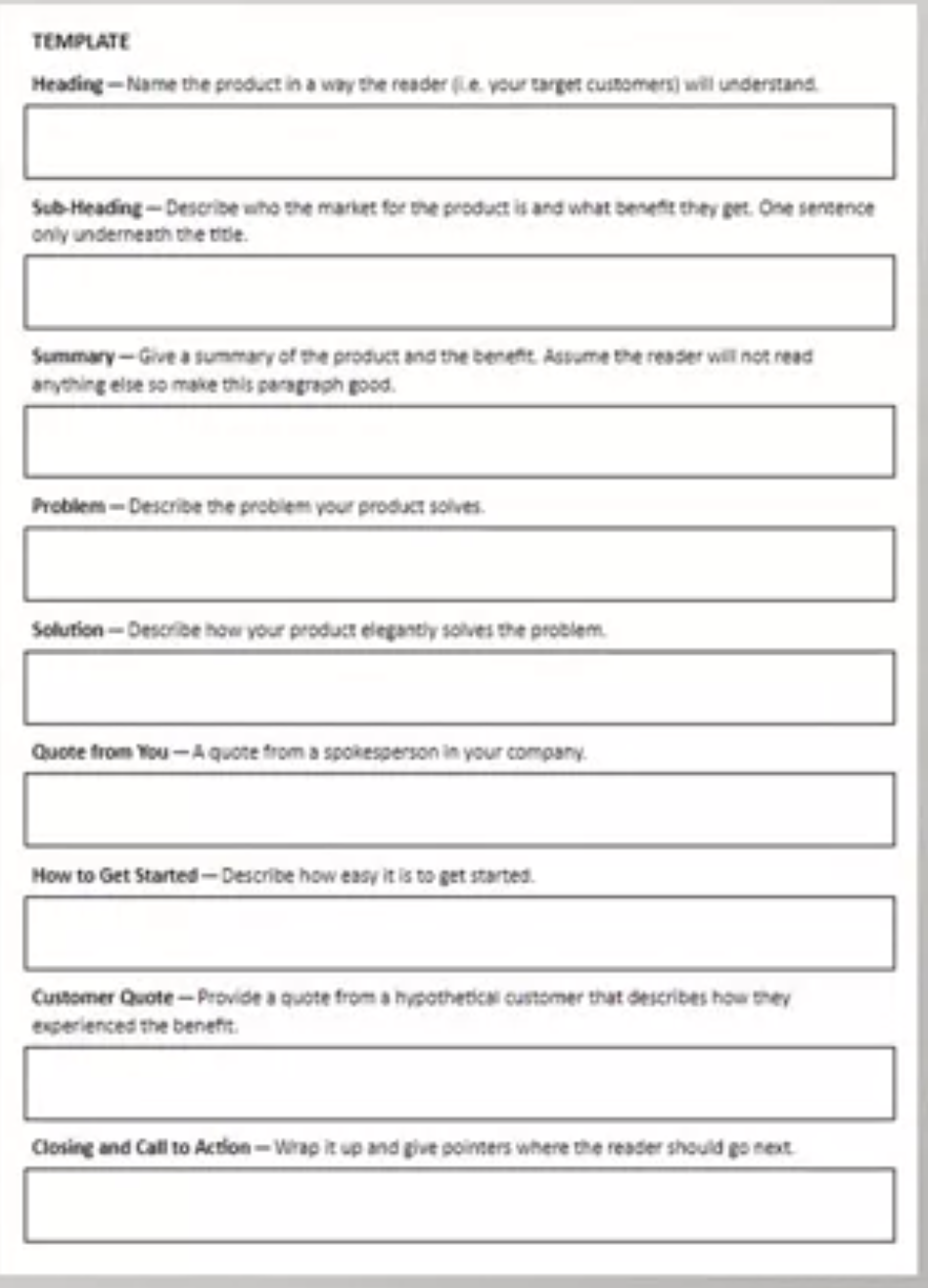
Further case studies
Target: Travis Klinker on Agile journey at Target Spotify Netflix Salesforce
Summary
[[W32KbPeoQlC9imz3qEJQtw_15eea422a636458baa1a08cfa4f93fe9_Agile-C4—Change-Management-Theories.pdf]]
Certificate
[[Coursera XWYB4PZP8DJW.pdf]]